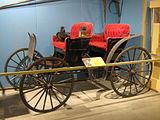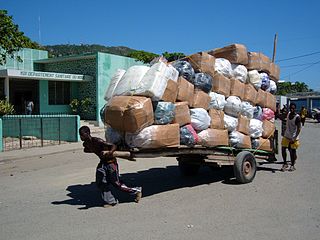
A cart is a vehicle designed for transport, using two wheels and normally pulled by one or a pair of draught animals. A handcart is pulled or pushed by one or more people. It is different from a dray or wagon, which is a heavy transport vehicle with four wheels and typically two or more horses, or a carriage, which is used exclusively for transporting humans.

A coupé or coupe is a passenger car with a sloping or truncated rear roofline and generally two doors.

A carriage is a wheeled vehicle for people, usually horse-drawn; litters (palanquins) and sedan chairs are excluded, since they are wheelless vehicles. The carriage is especially designed for private passenger use. A public passenger vehicle would not usually be called a carriage – terms for such include stagecoach, charabanc and omnibus but second-hand private carriages were common public transport, the equivalent of modern taxis. It may be light, smart and fast or heavy, large and comfortable or luxurious. Carriages normally have suspension using leaf springs, elliptical springs or leather strapping. Working vehicles such as the (four-wheeled) wagon and (two-wheeled) cart share important parts of the history of the carriage, as does too the fast (two-wheeled) chariot.

A wagon or waggon is a heavy four-wheeled vehicle pulled by draught animals or on occasion by humans, used for transporting goods, commodities, agricultural materials, supplies and sometimes people.

The hansom cab is a kind of horse-drawn carriage designed and patented in 1834 by Joseph Hansom, an architect from York. The vehicle was developed and tested by Hansom in Hinckley, Leicestershire, England. Originally called the Hansom safety cab, it was designed to combine speed with safety, with a low centre of gravity for safe cornering. Hansom's original design was modified by John Chapman and several others to improve its practicability, but retained Hansom's name.

A horse and buggy or horse and carriage refers to a light, simple, two-person carriage of the late 18th, 19th and early 20th centuries, drawn usually by one or sometimes by two horses. Also called a roadster or a trap, it was made with two wheels in England and the United States, and with four wheels in the United States as well. It had a folding or falling top.
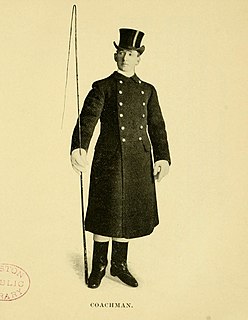
A coachman is a man whose business it is to drive a coach or carriage, a horse-drawn vehicle designed for the conveyance of passengers. A coachman has also been called a coachee, coachy or whip.

A phaeton was a form of sporty open carriage popular in the late eighteenth and early nineteenth century. Drawn by one or two horses, a phaeton typically featured a minimal very lightly sprung body atop four extravagantly large wheels. With open seating, it was both fast and dangerous, giving rise to its name, drawn from the mythical Phaëton, son of Helios, who nearly set the Earth on fire while attempting to drive the chariot of the Sun.

A brougham was a light, four-wheeled horse-drawn carriage built in the 19th century. It was named after the politician and jurist Lord Brougham, who had this type of carriage built to his specification by London coachbuilder Robinson & Cook in 1838 or 1839. It had an enclosed body with two doors, like the rear section of a coach; it sat two, sometimes with an extra pair of fold-away seats in the front corners, and with a box seat in front for the driver and a footman or passenger. Unlike a coach, the carriage had a glazed front window, so that the occupants could see forward. The forewheels were capable of turning sharply. A variant, called a brougham-landaulet, had a top collapsible from the rear doors backward.

A barouche is a large, open, four-wheeled carriage, both heavy and luxurious, drawn by two horses. It was fashionable throughout the 19th century. Its body provides seats for four passengers, two back-seat passengers vis-à-vis two behind the coachman's high box-seat. A leather roof can be raised to give back-seat passengers some protection from the weather.
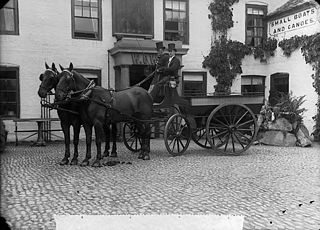
A brake was a horse-drawn carriage used in the 19th and early 20th centuries in the training of horses for draft work, or an early automobile of similar body design. A shooting-brake was a brake pressed into service to carry beaters, gamekeepers and sportsmen with their dogs, guns and game.

A chaise, sometimes called chay or shay, is a light two- or four-wheeled traveling or pleasure carriage for one or two people with a folding hood or calash top. The name, in use in England before 1700, came from the French word [“chaise”] through a transference from a sedan-chair to a wheeled vehicle.

A post-chaise is a fast carriage for traveling post built in the 18th and early 19th centuries. It usually had a closed body on four wheels, sat two to four persons, and was drawn by two or four horses.
A gun carriage is a frame and mount that supports the gun barrel of an artillery piece, allowing it to be manoeuvred and fired.

A buckboard is a four-wheeled wagon of simple construction meant to be drawn by a horse or other large animal. The "buckboard" is the front-most board on the wagon that could act as both a footrest for the driver and protection for the driver from the horse's rear hooves in case of a "buck". The buckboard is steered by its front wheels, which are connected by a single axle. The front and rear axle are connected by a platform of one or more boards to which the front axle is connected on a pivoting joint at its midpoint. A buckboard wagon often carries a seat for a driver. Such a seat may be supported by springs. The main platform between axles is not suspended by springs like a carriage. Made in the 18th century around the same time as carriages.

A horse-drawn vehicle is a mechanized piece of equipment pulled by one horse or by a team of horses. These vehicles typically had two or four wheels and were used to carry passengers and/or a load. They were once common worldwide, but they have mostly been replaced by automobiles and other forms of self-propelled transport.

The chariot that evolved from the ancient vehicle of this name took on two main forms:
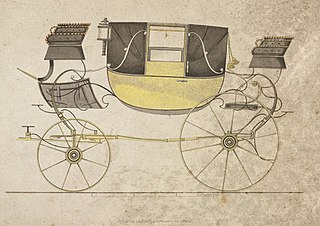
A landau is a coachbuilding term for a type of four-wheeled, convertible carriage. It was a city carriage of luxury type. The low shell of the landau provides maximal visibility of the occupants and their clothing, a feature that makes a landau still a popular choice for the Lord Mayors of certain cities in the United Kingdom on ceremonial occasions.

Driving, when applied to horses, ponies, mules, or donkeys, is a broad term for hitching equines to a wagon, carriage, cart, sleigh, or other horse-drawn vehicle by means of a harness and working them in this way. It encompasses a wide range of activities from pleasure driving, to harness racing, to farm work, horse shows, and even international combined driving.

A coach is originally a large, usually closed, four-wheeled carriage with two or more horses harnessed as a team, controlled by a coachman and/or one or more postilions. It had doors in the sides, with generally a front and a back seat inside and, for the driver, a small, usually elevated seat in front called a box, box seat or coach box. The term "coach" first came into use in the 15th century, and spread across Europe. There are a number of types of coaches, with differentiations based on use, location and size. Special breeds of horses, such as the now-extinct Yorkshire Coach Horse, were developed to pull the vehicles.


